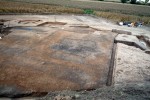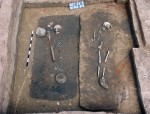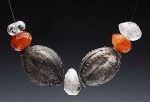 In 2007, an archaeological survey of a highway construction site near the central Polish town of Bodzia uncovered a Viking era cemetery with several dozen chamber graves dating to between 980/990 A.D. and 1030 A.D. Over the next two years, an excavation of the site revealed the remains of 14 men, 21 women and 14 children, and an extraordinarily rich collection of grave goods including weapons, jewelry, coins, amulet containers and the remnants of silk fabric, marking the cemetery as the final resting place for the élite.
In 2007, an archaeological survey of a highway construction site near the central Polish town of Bodzia uncovered a Viking era cemetery with several dozen chamber graves dating to between 980/990 A.D. and 1030 A.D. Over the next two years, an excavation of the site revealed the remains of 14 men, 21 women and 14 children, and an extraordinarily rich collection of grave goods including weapons, jewelry, coins, amulet containers and the remnants of silk fabric, marking the cemetery as the final resting place for the élite.
 Some of the artifacts are Scandinavian in origin, like silver beads with a traditionally Scandinavian granulation decoration, the weapons buried with a young man whose broken jaw and sliced face indicate he died in battle, and a few of the coins. The north-south orientation of the graves also suggests a Viking presence, since Slavic custom placed graves along an east-west axis while in the Scandinavian tradition people were buried north to south. The graves are relatively spacious, another Scandinavian style element, with wooden coffins lined in fabric and reinforced with iron fittings placed in deep burial pits. Eastern European graves at this time were more shallow and snug to the body.
Some of the artifacts are Scandinavian in origin, like silver beads with a traditionally Scandinavian granulation decoration, the weapons buried with a young man whose broken jaw and sliced face indicate he died in battle, and a few of the coins. The north-south orientation of the graves also suggests a Viking presence, since Slavic custom placed graves along an east-west axis while in the Scandinavian tradition people were buried north to south. The graves are relatively spacious, another Scandinavian style element, with wooden coffins lined in fabric and reinforced with iron fittings placed in deep burial pits. Eastern European graves at this time were more shallow and snug to the body.
 A unique feature of this cemetery is the remains of wooden palisades enclosing small groups of one to three graves. “Fences of the dead” have been found before in Britain, but they’re centuries older than the Bodzia cemetery and they weren’t fastened together at the corners like the Bodzia fences. Another rarity is a bronze balancing scale possibly used to weigh precious metals. Such artifacts are rare finds in Europe in general, and the first of its kind ever found in central Poland.
A unique feature of this cemetery is the remains of wooden palisades enclosing small groups of one to three graves. “Fences of the dead” have been found before in Britain, but they’re centuries older than the Bodzia cemetery and they weren’t fastened together at the corners like the Bodzia fences. Another rarity is a bronze balancing scale possibly used to weigh precious metals. Such artifacts are rare finds in Europe in general, and the first of its kind ever found in central Poland.
 Scandinavians had been trading and raiding in central and eastern Europe since the 9th century. Some of them settled in the area and became prominent citizens, often as mercenaries for kings like Mieszko I, founder of the Polish state and father of Boleslav the Brave, the first crowned King of Poland. The young warrior may in fact be connected to Boleslav. Bronze belt fittings found in his grave bear the insignia of Sviatopolk the Accursed, Boleslav’s son-in-law and ruler of the powerful Kievan Rus state east of Poland between 1015 and 1019. (He was Accursed because he killed three of his younger brothers to secure the throne. One he didn’t kill, Yaroslav, killed him and took the throne.)
Scandinavians had been trading and raiding in central and eastern Europe since the 9th century. Some of them settled in the area and became prominent citizens, often as mercenaries for kings like Mieszko I, founder of the Polish state and father of Boleslav the Brave, the first crowned King of Poland. The young warrior may in fact be connected to Boleslav. Bronze belt fittings found in his grave bear the insignia of Sviatopolk the Accursed, Boleslav’s son-in-law and ruler of the powerful Kievan Rus state east of Poland between 1015 and 1019. (He was Accursed because he killed three of his younger brothers to secure the throne. One he didn’t kill, Yaroslav, killed him and took the throne.)
The warrior cemetery of Bodzia, composed exclusively of chamber graves, is unique in early medieval Europe. It is located near the trading route of the rivers Vistula and Bug, connecting the Baltic Sea areas with the Byzantine world, and from Bodzia it is not far to the borders of Prussia. In the Kuyavia region, where Bodzia is sited, there are rich saline resources.
The discovery of Bodzia’s cemetery is the most recent and most spectacular example of a growing number of funerary sites found in Polish lands, dated to the period between the end of the tenth and the middle of the eleventh century and connected to the presence of migrants, mostly from Scandinavia. There is a certain regularity in the evidence. While in the pre-state period grave goods indicate a ‘domestic’ status for the deceased, many graves from the early Piast period, dated to the late tenth to mid-eleventh century, are distinguished by the frequent occurrence of weapons. Penetration of Scandinavians on the southern coast of the Baltic Sea was associated at that time with both the merchants’ commercial objectives and their military purposes
 The artifacts found are an eloquent testament to that synthesis: Scandinavian weapons for fighting, bronze balancing scale for trading, glass beads from Byzantium, silk from even further east, coins from Germany, England and Scandinavia.
The artifacts found are an eloquent testament to that synthesis: Scandinavian weapons for fighting, bronze balancing scale for trading, glass beads from Byzantium, silk from even further east, coins from Germany, England and Scandinavia.